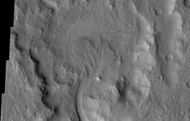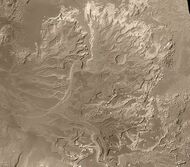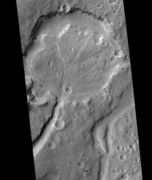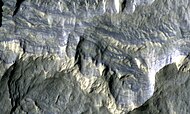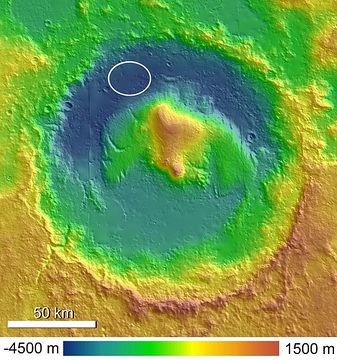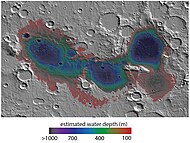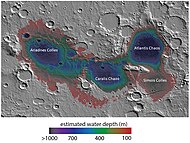Difference between revisions of "Lakes on Mars"
m |
m (→Images of possible deltas: added image) |
||
| Line 29: | Line 29: | ||
Image:Topographic Map of Gale Crater.jpg|Gale Crater with Aeolis Mons rising from the center. The noted [[Curiosity]] landing area is near Peace Vallis in Aeolis Palus. Curiosity landed in the northern part of the crater. | Image:Topographic Map of Gale Crater.jpg|Gale Crater with Aeolis Mons rising from the center. The noted [[Curiosity]] landing area is near Peace Vallis in Aeolis Palus. Curiosity landed in the northern part of the crater. | ||
| − | |||
</gallery> | </gallery> | ||
| + | [[File:7505 mars-curiosity-rover-gale-crater-beauty-shot-pia19839-full2.jpg|600pxr|View from the "Kimberley" formation on Mars taken by NASA's Curiosity rover.]] | ||
| + | View from the "Kimberley" formation on Mars taken by NASA's Curiosity rover. | ||
| − | |||
Revision as of 17:07, 13 August 2021
Lakes on Mars Article written by Jim Secosky. Jim is a retired science teacher who has used the Hubble Space Telescope, the Mars Global Surveyor, and HiRISE. It is believed that there were hundreds of lakes on Mars—over 200 just inside of craters. Water for the lakes came from various sources such as rainfall, runoff from surrounding land, melting of glaciers, and from groundwater sapping.
One evidence for lakes is the presence of deltas in craters. Deltas form when water flows into a quiet body of water.
Contents
Images of possible deltas
Possible delta in Margaritifer Sinus quadrangle as seen by THEMIS.
Probable delta in Eberswalde Crater that lies to the NE of Holden Crater, as seen by Mars Global Surveyor. Image in Margaritifer Sinus quadrangle.
Delta in Lunae Palus quadrangle, as seen by THEMIS.
Delta that fills a crater in Lunae Palus quadrangle, as seen by HiRISE.
Jezero Crater delta - chemical alteration by water (hi-res)
Some places that are believed to have once held lakes are Holden Crater, Jezero Crater, Gale Crater, Ritchey Crater, Columbus crater, Valles Marineris, Argyre basin, Hellas Basin, and large areas in Eridania.
Close-up of Channels on Rim of Holden Crater, as seen by THEMIS. Image is located in the Margaritifer Sinus quadrangle.
Gale Crater with Aeolis Mons rising from the center. The noted Curiosity landing area is near Peace Vallis in Aeolis Palus. Curiosity landed in the northern part of the crater.
View from the "Kimberley" formation on Mars taken by NASA's Curiosity rover.
Another major form of evidence is the finding of minerals such as clays, carbonates, and sulfates. These minerals require water to be produced. These minerals were both detected from orbit and from rovers on the surface of Mars. The Curiosity Rover has been exploring Gale crater for years with very sophisticated instruments. Many of the minerals identified were hydrated which required water. Some of these hydrated minerals are actinolite, montmorillonite, saponite, jarosite, halloysite, szomolnokite and magnesite. In some places 40 vol% of the minerals were hydrous minerals. [1]
Underground Lakes Near the South Pole
Deep penetrating radar detected several possible lakes of liquid water (or brine) under the polar cap near the South Pole. It was thought that these were kept liquid by geothermal heat. However, modelling suggested that they should freeze. Currently the theory is that they are not lakes at all, but bands of clay material. Under the right amount of pressure, they would give a radar return like water.[2]
See also
References
- ↑ Lin H.; et al. (2016). "Abundance retrieval of hydrous minerals around the Mars Science Laboratory landing site in Gale crater, Mars". Planetary and Space Science. 121: 76–82.
- ↑ https://www.scientificamerican.com/article/buried-lakes-on-mars-may-just-be-frozen-clay/
